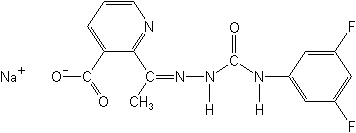-
Common NameDiflufenzopyr-sodium
-
中文通用名氟吡草腙钠
-
IUPACsodium 2-{(EZ)-1-[4-(3,5-difluorophenyl)semicarbazono]ethyl}nicotinate
-
CAS2-[1-[[[(3,5-difluorophenyl)amino]carbonyl]hydrazono]ethyl]-3-pyridinecarboxylic acid monosodium salt
-
CAS No.109293-98-3
-
Molecular FormulaC15H11F2N4NaO3
-
Molecular Structure
-
Category
-
ActivityDiflufenzopyr-sodium is for post-emergence use. The product has systemic activity.
Diflufenzopyr-sodium inhibits the polar transport of auxins in susceptible plants causing auxin accumulation at shoot and root meristems and, consequently, a disruption of normal growth patterns. Whilst the exact mode of action is unknown, it appears that diflufenzopyr binds to a specific carrier or efflux induction protein which is involved in the transportation of auxin away from the meristemic regions. A similar effect is exerted on the transport of dicamba which is the mixture partner in Distinct?; ?this results in increased translocation of dicamba to the meristems where its weed control activity is achieved at lower rates compared to applications of dicamba alone. Symptoms appear rapidly and plant death is usually achieved in days.
The selectivity in maize is due to rapid metabolism of both dicamba and diflufenzopyr-sodium in the crop. -
CropUseCrop uses:
Maize?
Diflufenzopyr-sodium will only be available in combination products.
-
Premix
Type
AI concn
Diflufenzopyr-sodium will only be available in combination products.
-
Toxicology
Acute oral (rat) : LD50 >5,000 mg/kg.
-
Environmental Profile
Bluegill sunfish [96 h]
LD50 >135 mg/L
Mallard duck
LD50 >5,620 ppm
Bee [contact]
LD50 >90 μg/bee
Rainbow trout[96 h]
LC50 106 mg/L
Bobwhite quail
LD50 >2250 mg/kg
Daphnia magna[48 h]
EC50 15 mg/L
Green algae [5 d]
EC50 0.11 mg/L
Fate in :
In acute studies submitted to the US EPA, diflufenzopyr-sodium was found to be practically non-toxic to avian species and honey bees and of low toxicity to small mammals. It was classed as slightly toxic to practically non-toxic to freshwater organisms and estuarine/marine organisms.
Diflufenzopyr-sodium is a herbicide and is classed as highly toxic to terrestrial plant species.Fate in soil:
The half-life of diflufenzopyr-sodium in aerobic soil in laboratory tests is 8-10 days; in a field dissipation study in Canada, the parent half-life was 4 days. The photolysis half-life of diflufenzopyr-sodium on soil is 13 days.
Diflufenzopyr-sodium is classed as mobile to very mobile in soil (Koc = 18-156 mL/g) as are its major metabolites (Koc = 128-1087).Fate in water:
The hydrolysis half-life is 13 days (pH 5), 24 days (pH 7), 26 days (pH 9).
The photolysis half-life is 7 days (pH 5), 17 days (pH 7), 13 days (pH 9).
The aerobic aquatic metabolism half-life is 25-26 days.
The anaerobic aquatic metabolism half-life is 20 days.
Based on the data submitted and the anticipated use patterns, the US EPA does not predict that diflufenzopyr-sodium will pose a risk to drinking water sources.
Porduct NewsMore
Canada granted continued registration of diflufenzopyr-sodium

 0
0 Subscribe
Subscribe
